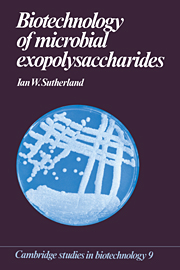Book contents
- Frontmatter
- Contents
- Preface
- 1 Introduction and definition
- 2 Polysaccharide analysis and structural determination
- 3 Exopolysaccharide structure
- 4 Enzymes degrading exopolysaccharides
- 5 Biosynthesis
- 6 Physiology and industrial production
- 7 Genetics, control and regulation of exopolysaccharide synthesis
- 8 Physical properties of exopolysaccharides
- 9 Food usage of exopolysaccharides
- 10 Industrial uses of microbial polysaccharides
- 11 Medical applications of exopolysaccharides
- 12 The future for microbial exopolysaccharides
- References
- Index
9 - Food usage of exopolysaccharides
Published online by Cambridge University Press: 09 September 2009
- Frontmatter
- Contents
- Preface
- 1 Introduction and definition
- 2 Polysaccharide analysis and structural determination
- 3 Exopolysaccharide structure
- 4 Enzymes degrading exopolysaccharides
- 5 Biosynthesis
- 6 Physiology and industrial production
- 7 Genetics, control and regulation of exopolysaccharide synthesis
- 8 Physical properties of exopolysaccharides
- 9 Food usage of exopolysaccharides
- 10 Industrial uses of microbial polysaccharides
- 11 Medical applications of exopolysaccharides
- 12 The future for microbial exopolysaccharides
- References
- Index
Summary
Polysaccharides are incorporated into foods to alter the rheological properties of the water present and thus change the texture of the product. Most of the polysaccharides used are employed because of their ability to thicken or to cause gel formation (Table 9.1). Advantage is also taken of the ability of some mixtures of polysaccharides to exhibit synergistic gelling: basically, for the two polymers to yield a gel at concentrations of each which will not in themselves form gels (Chapter 8). Associated with these readily measurable properties are others, such as ‘mouth feel’, which are more difficult to define but which also show some correlation with physical properties. ‘Mouth feel’ has been related to viscosity and, in particular, to non-Newtonian behaviour. This also relates to the masking effect of viscosity on the intensity of taste. There is also a specific relationship between the polysaccharide and flavours present in any food. Thus, corn starch and xanthan both provide good perception of sweetness and flavour when compared with gum guar or carboxymethylcelluose. In addition, polysaccharides are used because of their capacity to control the texture of foods and to prevent or reduce ice crystal formation in frozen foods; they may also influence the appearance and colour as well as the flavour of prepared foodstuffs (Table 9.2). It must also be remembered that many foodstuffs already naturally contain polysaccharides such as starch or pectin. Thus, addition of any further polysaccharide or polysaccharides will in all probability involve interactions with these compounds as well as with proteins, lipids and other food components.
- Type
- Chapter
- Information
- Biotechnology of Microbial Exopolysaccharides , pp. 117 - 125Publisher: Cambridge University PressPrint publication year: 1990
- 3
- Cited by



